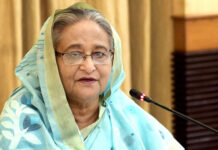
The International Monetary Fund has cut Bangladesh’s growth forecast to 6 percent for fiscal year 2022-2023.
In its latest World Economic Outlook report published yesterday, the Washington-based lender downgraded the projection of its April forecast of 6.7 percent growth citing high energy and food prices, inflation, higher interest rates, and Russia’s invasion of Ukraine.
It said inflation in Bangladesh would reach as high as 8.5 percent in the current fiscal year.
The IMF’s projection is in the same tune as that of the World Bank.
On Thursday, the World Bank also slashed the gross domestic product (GDP) growth forecast for Bangladesh for the current fiscal year to 6.1 percent from 6.7 percent because of inflation, energy shortage, slowdown of the recovery from the pandemic, and the war in Ukraine.
Last month, the Asian Development Bank also cut its projection for Bangladesh’s GDP growth to 6.6 percent for this fiscal year from 7.1 percent.
The government, meanwhile, has an ambitious target of 7.5 percent.
However, some leading economists of the country expressed doubt about whether the country would be able to attain even IMF’s slashed projection.
Ahsan H Mansur, executive director of the Policy Research Institute, said the lingering effect of the economic downtrend was not reflected in the IMF forecast.
The economist said the crisis just started when the IMF team visited the country three months ago. Back then, it was thought that the situation could stabilise soon.
“But it did not stabilise,” he said, adding, “Given the continuing uncertainty in the balance of payment, faltering export performance, declining remittances, and rapidly worsening power situation, it would be great if we can achieve 6 percent.”
According to the IMF forecast for other South Asian countries, the GDP of India would grow by 6.1 percent in FY23, the Maldives by 6.1 percent, Bhutan 4.3 percent, Nepal 5 percent, Pakistan 3.5 percent, and Sri Lanka’s GDP would shrink 3 percent.
In its report, the IMF trimmed its 2023 global GDP forecast to 2.7 percent, 0.2 points down from the July forecast.
Pierre-Olivier Gourinchas, the editor of the IMF Economic Review, warned that more than a third of the global economy is headed for contraction this year or next, and the three biggest economies — the United States, European Union and China — will continue to stall.
“The worst is yet to come and, for many people 2023 will feel like a recession,” said Gourinchas.
Former lead economist of the World Bank’s Dhaka office Zahid Hussain said, “The 6 percent GDP growth projection for FY23 is similar to the forecast from other international agencies … Nature has not been kind to agriculture this year while energy and electricity shortages show little sign of alleviation. The increased prices of raw materials and intermediate inputs also have contractionary effects.
“Domestic demand is likely to be compressed due to historic high inflation. External demand conditions are likely to get worse. The GDP contracted in the first half of 2022 in the US and a contraction in the second half of 2022 in the eurozone is imminent. These indicate significant headwinds for our exports. Remittances through formal channels have started to slow down since mid-September despite a surge in the number of Bangladeshi workers going abroad in the last year and a half.
“A 6 percent growth, if achieved, will in fact be outstanding at a time when global growth forecast is at 2.7 percent in 2023, in emerging and developing Asia at 4.9 percent, Latin America and the Caribbean 1.7 percent, Middle East and Central Asia 3.6 percent and Sub-Saharan Africa 3.7 percent. About a third of the world economies are facing two consecutive quarters of GDP decline.
“The message here is not to take anything for granted. Intensifying structural reforms to improve productivity and ease of trading internally and externally would ease supply constraints. At the same time, getting the external deficit under control will be critical to ensure the adequacy of foreign exchange availability.”












